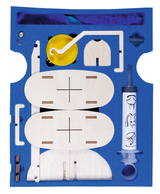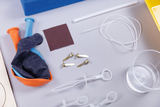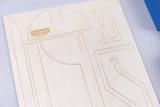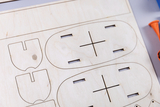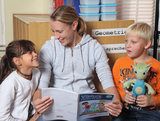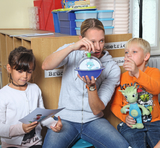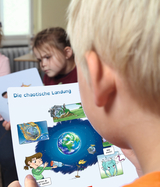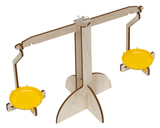Primary school experiments on air
Experimental set for 1 group Vinus explores the world - Topic Air
Equipment for 1 group (with concept stories).
Age 7-8
-
1 - Explore vacuum
experiment "Explore vacuum"
With the help of the vacuum pump, a rough vacuum can be created in Vinus' Ufo. The effects of the absence of air can be well observed and experienced by means of various partial experiments: Food changes in a vacuum (e.g. foam kiss), a small air-filled balloon expands; paper scraps or feathers start to move when the air flows back into the space capsule.
-
2 - Air and movement
experiment "Air and movement"
With the help of Vinus feathers, moving air can be made visible. Down springs and rod springs have different behavior. The cut sheet Vinus head can be used as an attachment for the springs.
-
3 - Air pressure and breathing
experiment "Air pressure and breathing"
Although children experience on themselves how the body changes when breathing in and out, air pressure as a phenomenon is difficult to grasp. Removing the air from the vacuum bag very impressively demonstrates the effects of air pressure (especially with the previously inserted Vinus doll without pillow). Household applications can be derived in an understandable way.
-
4 - Air brakes
experiment "Air brakes"
The children test the effects of changing the position and arm position of the Vinus skaters on the skateboards. With the help of a height-adjustable ramp (made from the remains of the woodcut sheets or constructed by the children themselves), the inclination can be varied and thus the speed of the skaters can be influenced. The students learn in a vivid way which parameters have an influence on the skateboard ride and to what extent air has a braking effect (air resistance).
-
5 - Air needs space
experiment "Air needs space"
The Vinus doll (backside without cushion) is inflated with the help of a straw and receives a counter pressure to the air pressure. It becomes apparent that the air introduced into the balloon and thus into the Vinus doll requires space.
-
6 - Weighing air
experiment "Weighing air"
The beam balance can be used to measure the difference between an air-filled balloon and an empty balloon as part of various setups. As a beam balance, the material also allows observation of two balloons filled with air, with air escaping from one with the help of a needle. By moving the tip bearing, the approximate weighing of a balloon filled with air can also be achieved.
-
7 - Air under water
experiment "Air under water"
Air, which is predominantly perceptible to children in its effects, is made visible here. Under water, the air introduced can be seen in the form of bubbles. The amount and shape of the bubbles vary depending on how the air is introduced into the water.
-
8 - Diving bell
experiment "Diving bell"
With the help of this experiment, the principle of the diving bell can be recreated: The children explore how Jojo can stay dry when he is in the water.
-
9 - Air displaced
experiment "Air displaced"
The students investigate the question of how air behaves in and under water. A beaker filled with water can be "drained" with the help of air.
-
10 - Air pressure works on all sides
experiment "Air pressure works on all sides"
The children experience the omnidirectional effect of air pressure with the aid of the Ufo demo set (principle of action of the Magdeburg hemispheres). The hemispheres can be pressed together and evacuated using the vacuum pump. They cannot then be separated from each other. Even with only the upper hemisphere of the UFO, the effect of air pressure can be demonstrated when it is pressed sideways and even upside down against a smooth surface and then evacuated using the vacuum pump. The air pressure thereby provides a stable attachment to the surface.
-
11 - Air resistance
experiment "Air resistance"
The students investigate air resistance with the help of the Vinus hands. Fast and slow movements or an increased surface area with several subjects show different effects.
-
12 - Air moves
experiment "Air moves"
In simple setups, the children learn that air has a force that can be used as a drive. Air movements can be made visible in the Vinus head (equipped with various springs). The skaters can be moved/accelerated by blowing or propelled in one direction or the other in competition against each other.
-
13 - Measuring and weighing
experiment "Measuring and weighing"
The children make their first experiences with the weighing principle. They first explore the possibilities of comparing lighter and heavier objects using the seesaw. Converting the wooden parts into a beam scale allows them to weigh using "weights". Small everyday objects can be used excellently for this purpose.
- 1 × Beaker, plastic, 100 ml
- 1 × Dish, plastic, yellow 150x140x35mm
- 1 × Plastic tube 120x5 mm
- 2 × Cutting sheet Vinus figure
- 1 × Cutting sheet Vinus head
- 1 × Skateboard + rocker rack
- 1 × Syringe, 50 ml
- 4 × Vinus feather on stick, blue
- 4 × Vinus down feather, blue
- 2 × Vinus hand fan, right
- 1 × Scale set
- 1 × Seesaw support
- 4 ×
- 1 ×
- 1 ×
- 3 ×
- 5 ×
- 8 ×
- 2 ×
- 1 ×
- 1 ×
- 3 ×
- 2 ×
- 1 × Demonstration cord 20 m, 1 mm Ø
recommendations
Art. no. 33106
This is a typical excerpt from one of the stories about the little extra-terrestrial creature Vinu...
Details
